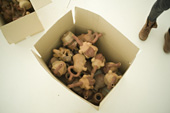- Exhibition program
- The End Is Where We Start From
- Artist
- Daniela Ortiz
- Dates
- —
- Curated by
- Karin Campbell
Human Resources, a new project by Daniela Ortiz, considers how the condition of being “other” impacts the role one plays within a society’s economic and social infrastructure. Ortiz focuses this study through the lens of two countries: her native Peru and Spain, where she moved in 2007. The project traces a conceptual line from the “Laws of the Indies,” established by the Spanish crown in the 15th century to govern the native population in its Latin American colonies, to contemporary immigration law in Spain.
In the late-1990s, Spain adopted an open-door policy leading its number of immigrants to skyrocket. When the Spanish economy spiked in the early 2000s, immigrants were a welcome addition to the large labor force needed for financial growth, particularly in sectors with lower-paying jobs, such as construction and hospitality. Yet over the last several years, as Spain has slipped into a recession and its unemployment rate has soared, immigration has become a controversial topic, with race issues often taking center stage. These circumstances led Ortiz to turn a critical eye toward the political climate in Peru, where a heated presidential election earlier this year intensified the already sharp racial and economic divide between indigenous peoples and Peruvians of Spanish decent.
The indigenous Peruvian population is plagued by serious poverty, yet has received little support from the state in recent years as the government has turned its energies toward framing Peru as a modernized, flourishing nation. Indigenous peoples are often accused of stunting the country’s growth because they maintain a strong connection to their cultural heritage and traditional lifestyles, yet they contribute substantially to Peru’s booming tourism industry by producing souvenirs like hand-woven textiles and huacos, ceramic vessels shaped like human heads. Once used for religious and ceremonial purposes, today these objects are hot commodities for tourists visiting the region.
Human Resources includes textiles and hundreds of huacos that Ortiz had custom-made in Peru and then exported to Barcelona. In a radical reversal of Spain’s employer/employee paradigm, Ortiz, a non-native resident, hired three Spanish men to throw the vessels against a wall in Espai 13. Devoid of cultural significance but pregnant with social implications, the shattered huacos litter the gallery floor while a multi-channel video installation documenting the violent act occupies the room’s side corridor. The textiles, made by illiterate indigenous Peruvian women, contain fragments of the laws mentioned above. These weavings are unconventional in their use of the written word, but more important is the subtle subversion involved in repurposing and reclaiming language that is partially responsible for the social statuses of those making the textiles. By involving a variety of individuals in the production and destruction of these objects, Ortiz calls attention to the human relationship with labor and the shifting laws, both written and unwritten, that define this connection.
Karin Campbell
Curator, The End is Where We Start From



